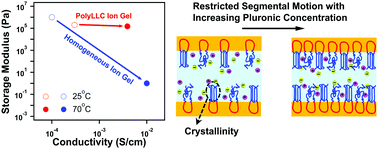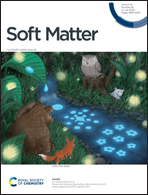Formation of ion gels by polymerization of block copolymer/ionic liquid/oil mesophases†
Abstract
In this study, we introduce a new method of developing ion gels through polymerization of lyotropic liquid crystal (LLC) templates of monomer (styrene), cross-linker (divinylbenzene), ionic liquid (1-ethyl-3-methylimidazolium tetrafluoroborate), and amphiphilic block copolymers (Pluronic F127). The polymerization of the oil phase boosts the mechanical properties of the ion-conducting electrolytes. We discuss the effect of tortuosity induced by crystalline domains and LLC structure on the conductivity of ion gels. The ion transport in polymerized LLCs (polyLLCs) can be controlled by changing the composition of the mesophases. Increasing the block copolymer concentration enhances the crystallinity of PEO blocks in the conductive domains, which slows down the dynamics of PEO chain and ion transport. We show that by adjusting the composition of LLC mesophases, the mechanical strength of ion gels can be increased one order of magnitude without compromising the ionic conductivity. The polyLLCs with 45/25/30 wt% (block copolymer/IL/oil) composition has storage modulus and ionic conductivity higher than 1 MPa and 3 mS cm−1 at 70 °C, respectively. The results suggest that LLC templating is a promising method to develop highly conductive ion gels, which provides advantages in terms of variety and processing.



 Please wait while we load your content...
Please wait while we load your content...